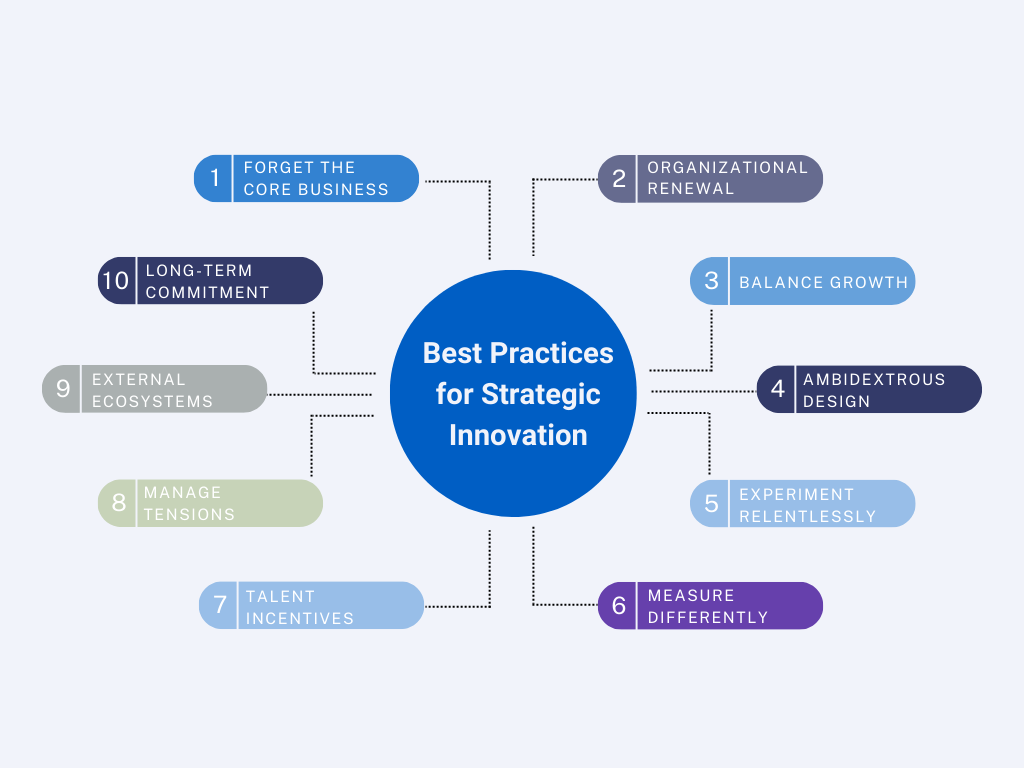What if the way you think about innovation is too narrow? Many leaders still equate it with launching a new product, running a digital project, or keeping up with the latest tech trends. But here’s the truth: those moves rarely shift the game on their own. To stay ahead, organizations need something bigger, such as strategic innovation.
This is the kind of innovation that doesn’t happen in a lab or in isolated projects. It’s woven into the business strategy itself. It’s how companies use disruption—AI, shifting customer behaviors, global competition—not as threats but as catalysts to reinvent models, markets, and mindsets.
The result? Leaders who practice strategic innovation uncover opportunities before rivals do, build resilience against uncertainty, and turn bold ideas into lasting advantage. In this article, we’ll break down what it really means, why it matters for you, and how to put it into practice with examples and insights you can act on.
- What is strategic innovation?
- 10 best practices for driving strategic innovation
- The main advantages of adopting strategic innovation in your business
- How does innovation in tech drive strategic innovation?
- 5 real-world examples of strategic innovation
- Why study strategic innovation now?
What is strategic innovation?
Strategic innovation is the deliberate integration of innovation into business strategy. It is not about making incremental improvements to existing products or processes. Instead, it redefines how an organization creates value, competes, and grows over the long term.
Consider Apple and the launch of the iPhone. The device itself was impressive, but the real breakthrough was the ecosystem of applications, services, and partnerships that followed. This was not a single product innovation but a complete reimagining of the business model and customer experience. That is what strategic innovation looks like in practice.
Strategic innovation can be understood as the combination of three elements:
- Fresh ideas: discovering new ways to solve problems or serve customers.
- Strategic alignment: ensuring those ideas directly support the company’s long-term goals.
- Scalable impact: turning innovation into measurable growth, resilience, and competitive advantage.
This blend of fresh ideas, strategic alignment, and scalable impact is what allows organizations not just to adapt, but to actively shape the future of their industries. The question, then, is why this matters so much for leaders today.
10 best practices for driving strategic innovation
To put strategic innovation into practice, leaders need guiding principles that connect bold ideas with long-term strategy. These ten essentials highlight how to embed innovation into culture, technology, and leadership choices, ensuring it becomes a lasting source of growth.
Here is a summary of the ten rules that define successful strategic innovation:

1 | Forget the core business | New ventures cannot be managed with the same processes, metrics, or expectations as established operations. They require fresh approaches. |
2 | Build a new organizational DNA | Innovation initiatives need their own culture, structures, and ways of working to thrive. |
3 | Balance the core and the new | Leaders must protect the current business while also investing meaningfully in future opportunities. |
4 | Create ambidextrous organizations | The most effective companies run efficient existing operations while experimenting with new ones simultaneously. |
5 | Experiment relentlessly | Treat every innovation as a hypothesis. Testing, learning, and adapting must become second nature. |
6 | Measure differently | Traditional KPIs often stifle new ventures. Instead, focus on metrics that capture learning and market validation. |
7 | Recruit and reward differently | Innovation requires entrepreneurial talent, which must be motivated with tailored incentives. |
8 | Manage the inevitable tensions | Conflict between the core and the new is natural. Leaders must anticipate and actively manage these tensions. |
9 | Leverage external ecosystems | Partnerships, alliances, and networks expand reach and accelerate innovation. |
10 | Commit for the long term | Strategic innovation rarely delivers overnight. It demands patience, sustained investment, and resilience. |
The main advantages of adopting strategic innovation in your business
In today’s environment, where AI breakthroughs, shifting customer expectations, and geopolitical uncertainty redefine the rules of competition, incremental improvements are no longer enough.
Businesses that rely only on small adjustments risk falling behind. Strategic innovation gives organizations the ability to anticipate disruption, craft bold responses, and build resilience into their long-term strategy.
To understand its real impact, let’s look at the concrete advantages this way of thinking creates for businesses like yours:
It allows your business to build sustainable competitive advantage
A true sustainable competitive advantage is not built on products alone, but on the ability to anticipate market shifts and respond faster than competitors. Strategic innovation allows businesses to spot opportunities early, adapt models before rivals do, and embed differentiation into the very fabric of their strategy.
This creates an edge that competitors cannot easily copy, ensuring relevance and resilience over the long term.
It helps your business unlock new growth opportunities
Strategic innovation also drives expansion into untapped markets and the creation of new revenue streams. Amazon’s move from retail into cloud computing with AWS is a powerful example of how reframing strategy around innovation can transform a business. Companies who cultivate this mindset are better placed to diversify and capture growth even in saturated industries.
It enables your business to strengthen resilience and adaptability
Volatile environments require organizations to pivot quickly. Strategic innovation enables this by encouraging experimentation, scenario testing, and the use of data-driven insights.
The pharmaceutical sector’s rapid response during COVID-19 illustrated how innovation aligned with strategy can accelerate solutions at scale, while building resilience for future crises.
It supports your business in enhancing efficiency through technology
Artificial intelligence and other innovative technologies are transforming operations across industries. Strategic innovation ensures these tools are not adopted in isolation but are integrated into business models to drive efficiency. From predictive analytics in supply chains to automation in customer service, this integration frees up resources for higher-value initiatives.
It empowers your business to attract and retain top talent
Innovation is also about people. A culture that embraces strategic innovation signals to employees that creativity and experimentation are valued. This attracts ambitious professionals and encourages them to stay, creating a cycle where talent and innovation continuously reinforce one another.
In short, strategic innovation provides a framework for growth, resilience, and long-term relevance, turning disruption from a threat into an opportunity. But what does this look like when applied in the real world?
How does innovation in tech drive strategic innovation?
Technology has always been a driver of progress, but today its role in shaping strategy is unprecedented. From artificial intelligence and cloud computing to blockchain and advanced robotics, innovation in tech is redefining how companies compete and deliver value.
Organizations that succeed at this do not treat technology as a series of standalone projects. Instead, they integrate it into their business models to create innovative solutions that scale. For example:
- AI in HR improves recruitment, predicts retention risks, and personalizes career development, helping organizations build more efficient and engaged workforces.
- Blockchain in supply chains improves transparency and trust, giving companies a strategic edge in industries where provenance matters.
- Cloud computing allows firms like Amazon to expand far beyond their original core businesses, illustrating how technology can fuel entirely new growth engines.
The key lesson is clear: technology on its own does not guarantee success. It becomes strategically valuable only when leaders embed it into their organization’s vision, culture, and execution. This alignment is what transforms emerging technologies into sustained competitive advantage.
5 real-world examples of strategic innovation
Around the world, leading companies are already applying strategic innovation practices to unlock growth and stay resilient in volatile environments. Let’s take a look at a few examples that show how aligning innovation with strategy creates real impact.
1. Nintendo: redefining gaming with the Wii
Nintendo’s launch of the Wii is a classic case of strategic innovation and an example of Blue Ocean Strategy. . Rather than competing on graphics or processing power, Nintendo reimagined what gaming could be by focusing on motion-sensing controls and family-friendly design.
This shift was not just a product improvement but a strategic choice to expand the market, attract new players, and create an entirely different source of growth.
2. Netflix: using data to reinvent entertainment
Netflix illustrates how innovation in tech can redefine an industry when tied to strategy. By leveraging AI-driven algorithms to personalize content and predict viewing habits, Netflix moved from DVD rentals to streaming dominance. Its strategic innovation lies in continuously adapting its model to changing technologies and customer expectations.
3. Tesla: disruptive innovation with a long-term vision
Tesla demonstrates how disruptive innovation can transform markets when tied to strategy. Beyond producing electric vehicles, Tesla positioned itself as a technology and energy company. Its investments in batteries, charging infrastructure, and AI-powered autonomous driving illustrate how strategic innovation integrates multiple bets into a unified long-term vision.
4. Unilever: innovation aligned with sustainability
In consumer goods, Unilever has embedded strategic innovation insights into its sustainability agenda. From reimagining packaging to sourcing responsibly, its innovation is not just about new products but about building a resilient, purpose-driven business model. This approach has differentiated Unilever in competitive markets and strengthened customer trust.
5. Microsoft: leveraging AI for strategic advantage
Microsoft’s rapid pivot to cloud computing with Azure and its current leadership in AI integration highlight the role of innovation in tech as a strategic lever. By embedding AI across products and services, Microsoft has expanded its relevance beyond software to become a central player in enterprise transformation.
These cases underline one point: strategic innovation is not about isolated initiatives. It is about aligning vision, technology, and execution to create impact that endures.
Why study strategic innovation now?
The pace of change has never been faster. Artificial intelligence, shifting customer expectations, and global uncertainty are rewriting the rules of competition across industries. For leaders, the question is no longer if innovation should be part of strategy, but how quickly they can embed it into every dimension of the business.
Studying strategic innovation gives executives the frameworks and tools to make sense of disruption and turn it into advantage. It empowers leaders to design new business models, identify growth opportunities before competitors do, and build cultures where innovation becomes a disciplined practice rather than a side project.
In short, it equips organizations not only to survive but to thrive in the face of uncertainty.
This is exactly what IMD’s Driving Strategic Innovation program, developed in collaboration with MIT Sloan, is designed to deliver. It helps leaders rethink their innovation and technology strategies, explore value chain design and project execution, and master the cultural shifts needed to sustain innovation. Participants leave the program with the confidence, insights, and capabilities to influence culture, strengthen partnerships, and achieve breakthrough performance.
The message is clear: innovation alone is not enough. Only when innovation is guided by strategy does it become a lasting source of growth and resilience. The time to act is now.
Get the latest governance content in your inbox 💌
